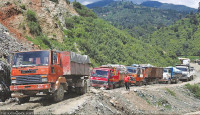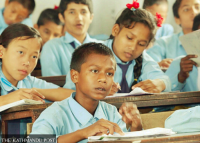Opinion
Money at fingertips
Mobile financial services enhance the access of rural people to remittance services
Dutta Shree Duwadi (khanal)
Many South Asian remittance markets have been undergoing an important modernisation process, particularly the introduction of mobile financial services that include mobile banking. Mobile banking refers to many types of financial transactions including mobile phone payment, loan disbursement and repayment, savings deposit and withdrawal and money transfer, among others.
Despite an increase in the flow of remittance in the South Asian region and in Nepal, the disorganised way it is being done has raised questions about its effectiveness and pushed up costs. Mobile financial services are also expected to minimise the cost of collecting the money that has been sent besides enhancing the access of rural people to remittance services.
It is necessary to raise awareness about the scale and scope of South Asian remittance, particularly to rural areas, in order to encourage the private sector, civil society and governments to engage directly in maximising the development impact of these flows. Further, it is necessary to address legal and regulatory restrictions with a view to promoting financial access in rural areas to make the remittance market more competitive. Besides implementing the general principles of channelling remittance, partnerships with commercial banks, particularly to broaden the financial options available to remittance receiving households, can help yield the desired results. Modernising other key remittance paying systems such as post offices, micro finance institutions (MFIs) and mobile network operators can also help in this regard.
A huge market
About 28 million South Asian migrant workers reside abroad, making the region the largest source of migrants on the continent. There was a substantial increase in departures from Afghanistan, India, Pakistan and Sri Lanka in the last decade.
In contrast, Bangladesh and Nepal had substantial reductions as many citizens returned home over the period. MFIs, post offices and money transfer operators (MTOs) have a significant presence in South Asia where a majority of the people live in rural areas. Mobile banking can add value to the services being provided through these channels. Furthermore, the advent of new technologies delivered through mobile networks is creating opportunities to expand the scope of this market. However, lack of regulatory frameworks and institutional capacity have prevented these networks from securing a significant market share.
South Asia is the world’s fastest growing market for mobile financial services. Besides being a means of communication, mobile phones can also be one of the best ways to send money, check bank accounts, transfer money between accounts and pay bills even in rural areas. In addition, the services can be used to receive and store value, make purchases at retail stores and withdraw money from banks. In this regard, money transfer offices, banks and telecommunication companies have been playing a leading role in South Asia by allowing customers to receive, monitor and use money through their cellular devices. A vast majority of remittances are now cash-to-cash transactions. This is because most of the remittance senders and receivers do not have access to or know about financial services.
Pakistan, India, Nepal, Bangladesh and Sri Lanka have adopted specific policies to attract remittance from their overseas populations. However, the desired output has not been achieved due to the slow progress in expanding financial services. Although MFIs could be the main means to channelise remittance into productive businesses, they are reluctant to get involved. This is because, one, regulations in most countries do not allow them to perform foreign currency transfers unless they participate as sub-agents of commercial banks or authorised entities; and two, most of them do not have trained staff to meet regulatory compliance rules, lack infrastructure to handle remittance, are deficient in data management systems and are low on cash.
In this regard, the use of mobile phones can connect hundreds of millions of unbanked and low-income people to financial services at low costs. Since reducing costs is central to improving competitiveness, MTOs, banks and telecommunication companies play a leading role in Asia by allowing customers to receive, monitor and use money through their cell phones. Mobile financial services also ensure the maximum safety measures. In Nepal, USAID’s NEAT project had recognised the potential of mobile financial services to reach unbanked households. NEAT organised Nepal’s first Mobile Financial Services Summit in 2012. This summit was successful in creating a different vibe among bankers, regulators, platform providers and telecommunication service providers. Nepal Rastra Bank also released mobile banking regulations and announced its willingness to revisit and improve them as banks and regulators gain more experience.
Financial inclusion
In recent days, mobile banking has also received global attention as it is expected to eventually replace traditional cash transfer processes. In rural areas, MFIs and post offices receive mobile money as they have to deal with large amounts of cash. The partnership between MFIs, post offices and money network operators has provided a valuable set-up for a sustainable mobile money based system. As this partnership brings a large amount of clients by
making regular transactions, there should be a mutually symbiotic relationship between them in the long run. The coordination also ensures the safety of cash transfers. The growth of mobile financial services will be beneficial to all sectors and recipients as it makes payments faster, more convenient, more secure and more accessible to a greater number of senders and recipients. In rural areas, clients will benefit from money transfer and other mobile and online services.
Even though there are many challenges in expanding the service to rural areas of South Asia, this type of technology should be promoted to make financial services cheaper and faster. Thus, leaving the traditional way of sending remittance through ‘Hundi’ and adopting the new mobile banking system are ways to receive remittance at less cost. It is necessary to strengthen commitment to financial inclusion, particularly through literacy programmes. Moreover, expanding access to technology is necessary to promote asset building and investment mechanisms among the non-resident population for the development of South Asia.
Duwadi is programme manager at the South Asian Institute of Policy Analysis and Leadership




 21.12°C Kathmandu
21.12°C Kathmandu










